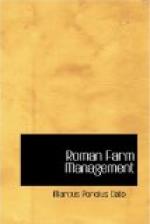So far Stolo, when Scrofa began again. “The owner should have an inventory of all the farm implements and equipment, with a copy on file both at the house and at the steading, and it should be the duty of the overseer to see that everything is checked against this inventory and is assigned its appropriate keeping place in the barn. What cannot be kept under lock and key should be kept in plain sight, and this is particularly necessary in respect of the utensils which are used only at intervals, as at harvest time, like the grape baskets and such things, for what ever one sees daily is in the least danger from the thief.”
3 deg. CONCERNING THE OPERATION OF A FARM
XXIII. “And now,” interposed Agrasius, “as we have discussed the two first parts of the four-fold division of agriculture, namely: concerning the farm itself and the implements with which it is worked, proceed with the third part.”
Of planting field crops
“As I hold,” said Scrofa, “that the profit of a farm is that only which comes from sowing the land, there are two considerations which remain for discussion, what one should sow and where it is most expedient to sow it, for some lands are best suited for hay, some for corn, some for wine and some for oil. So also should be considered the forage crops like basil, mixed fodder, vetch, alfalfa, snail clover and lupines. All things should not be sown in rich land, nor should thin land be left unsown, for it is better to sow in light soil those things which do not require much nourishment, such as snail clover and the legumes, except always chick peas (for this also is a legume like the other plants which are not reaped but from which the grain is plucked) because those things which it is the custom to pluck (legere) are called legumes. In rich land should be sown what ever require much nourishment, such as cabbage, spring and winter, wheat and flax. Certain plants are cultivated not so much for their immediate yield as with forethought for the coming year, because cut and left lying they improve the land. So, if land is too thin it is the practice to plough in for manure, lupines not yet podded, and likewise the field bean, if it has not yet ripened so that it is fitting to harvest the beans.[81]
“Not less should you make provision for cultivating what yields you profit in mere pleasure, like arbours and flower gardens: and those plantations which do not serve either for the support of man or the delight of the senses, but are not the less useful in the economy of the farm. Thus suitable places must be set aside for growing willows and reeds and other such things which affect wet places. On the other hand, you should sow field beans as much as possible in your corn land. There are other plants which seek dry places, and still others demand shade, like asparagus, both when wild and cultivated: while violets and garden flowers, which flourish in the sun should be set out in the open.




